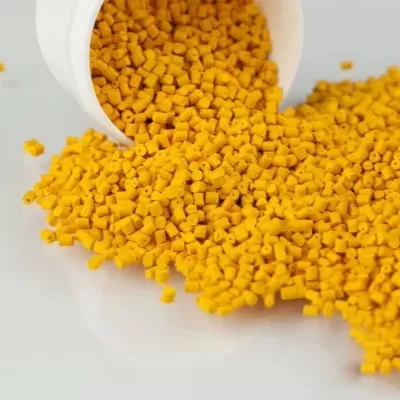

TPEE vs TPE Please check out this article.
1.Excellent Mechanical Properties
High tensile strength: TPEE can withstand very high tensile stress, deformation can be quickly recovered.
Tear-resistant properties: the material is excellent under severe friction or external impact, suitable for high-strength applications.
2.Wide Temperature Range
Use temperature range from -40 ℃ to 150 ℃, in the high temperature does not soften, low temperature does not brittle.
Suitable for use in extreme climates or application scenarios with large temperature differences.
3.Excellent Chemical Resistance
TPEE has good resistance to chemicals such as grease, solvents, fuels and acids and alkalis.
No significant aging phenomenon in industrial oil and chemical contact environment for long-term use.
4.Environmental Protection And Flame Retardant Properties
Low smoke and halogen free TPEE / halogen free flame retardant TPEE, through modification, can realize low smoke and halogen free (LSZH) characteristics, very low smoke when burning, and does not contain harmful halogen compounds. Halogen-free flame retardant performance to meet international standards such as UL94 V-0 grade, is the preferred material for environmentally friendly cables and devices.
5.High Processability
With the characteristics of thermoplastics, can be processed many times, suitable for injection molding, extrusion and other molding processes, high production efficiency.
TPEE particles are widely used in the production of cable sheathing and insulation materials due to its comprehensive performance, especially in the high-end cable market with unique advantages.
1.Cable Sheathing
The high strength and aging resistance of TPEE materials make them particularly good in cable jacketing:
Abrasion resistance: excellent performance in repeated bending and rubbing, suitable for industrial robot cables and automation equipment cables.
Environmental resistance: Highly resistant to UV and ozone aging for long-term exposure to outdoor environments.
2.Insulation Materials
The application of TPEE in insulation is equally important:
Excellent electrical insulation properties, suitable for high-frequency signal transmission cables, such as communication fiber optic cables.
Good impact resistance, even in harsh environments can provide stable electrical protection.
3.Typical Examples
·Low-smoke halogen-free cable material
Characteristics: TPEE material produces very little smoke when burning and is completely halogen-free, meeting the international environmental standards for low-smoke, halogen-free cables (such as IEC 60754).
Application scenarios: construction cables, rail transportation cables, aviation and marine cables.
·Halogen-free Flame Retardant Cable Material
Characteristics: Through modification, TPEE particles can realize halogen-free flame retardant performance and reach UL94 V-0 grade.
Application scenarios: new energy vehicle charging cables, high-speed train cables, 5G base station communication fiber optic cables.
·Highly flexible cable material
Characteristics: The high flexibility and abrasion resistance of TPEE materials are especially suitable for complex bending and long-term movement scenarios.
Application scenarios: industrial robot cables, data center high-frequency cables.
1.New Energy Vehicles
TPEE particles have become the mainstream material for high-voltage cables and charging cables in new energy vehicles due to its heat resistance, chemical resistance and environmental friendliness. Its low-smoke halogen-free and flame-retardant properties provide a higher level of safety for automotive cables.
2.5G communication cable
The 5G era requires high-performance signal transmission cables, TPEE's anti-fatigue and high-strength performance makes it an ideal choice for fiber optic cables, effectively meeting the needs of high-frequency communications.
3.Rail transportation and aviation cables
In the field of rail transportation and aviation, TPEE materials can not only provide reliable mechanical protection, but also meet the requirements of lightweight and high security.
4. Medical and Consumer Electronics
In medical cables and consumer electronics connecting cables, the flexibility and durability of TPEE ensures a long service life and a high degree of comfort.